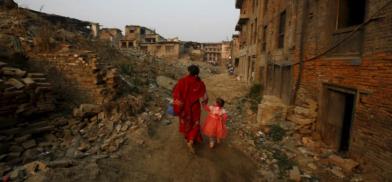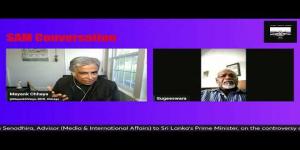Climate crises affect women more: Vulnerabilities of Nepalese women increased manifold after 2015 earthquake
According to a UN report, three months after the quake in Nepal at least 245 children had been preyed upon by traffickers and that was just the “tip of a growing iceberg”

If climate crisis is a threat, what is the threat multiplier? The threat multiplier is the magnifying inequalities, especially discrimination, violence and victimization that women in South Asia particularly face in recurring ways. Though it’s true that all genders are at increased risk of victimization at such times, women and girls are most affected due to climate crises and natural disasters. Research has indicated that women in the Global South face reinforced disparity as a consequence of climate crises and their vulnerabilities increase manifold aggravated by poverty and rigid gender stereotypes that often make them succumb to human trafficking.
A classic example is Nepal where the chaos that followed post the 2015 earthquake accentuated the sex trade for girls and women. Traffickers camouflaged as rescue operators lured and kidnapped women in the name of relief distribution. Sita 20, told The Guardian newspaper how she had been taken from her village in Sindupalchowk, north of Kathmandu to the Indian border town of Siliguri where she was sold to a brothel owner, repeatedly raped by hundreds of men and beaten. She later became infected with HIV AIDS. Sita was taken by an uncle to India. Rashmita Shashtra, a local health worker said, “The earthquake will definitely increase the risk of abuse. People here are now desperate and will take any chance. There are spotters in the villages who convince family members and local brokers who do the deal. We know who they are.” (Jason Burke, ‘Nepal quake survivors face threat from human traffickers supplying sex trade’, The Guardian, 5 May 2015)
A number of NGOs such as Maiti Nepal, WOREC, and Women for Human Rights (WHR) all reported that the chaos that followed the earthquake also led to an increase in trafficking (UNICEF, 2015). Trafficking rose during this time. One reason was that traffickers took advantage of the vulnerable situation of children, especially girls and women and were able to exploit the anxiety and desperation following a natural disaster with their usual tactics. For instance, after the 2015 earthquake in Nepal traffickers posed as trustworthy saviours of the distressed. It was easy for them to convince parents to give up their children for proper education, food and a better life. Luring them away in lieu of job opportunities was good bait. Most of the time, the parents do not realise that the job opportunities are fake and the children are in danger. (Source: Kay Standing, Sara Parker, Sapana Bista, ‘It's breaking quite big social taboos’ violence against women and girls and self-defence training in Nepal’, Women’s Studies International Forum, 2017)
The United Nations reckoned that around 40,000 women were at immediate risk of gender-based violence in post-earthquake Nepal (Inter-Cluster Gender Task Force, 2015) with reports of increased risk of trafficking across the border with India. (Basnet, Sapana and Standing, Kay and Parker, Sara and Sharma, Saurabh, ‘Violence Against Women and Girls in Humanitarian Crisis: Learning from the 2015 Nepal Earthquake February 21, 2022. South Asia Journal of Law Policy and Social Research, Vol. 1, No. 2, 2022. Available at SSRN: https://ssrn.com/abstract=4039954)
A double disaster for Nepalese women
Nepal is a patriarchal society with entrenched gender norms. Women who flout these gender norms can face resistance. The male identity is very much imagined as machismo and gendered. Although there have been attempts to change the law, there are unequal citizenship rights and a culture of silence around violence against women. Against this background of a highly discriminatory society and pre-existing violence against women, the 2015 earthquake increased the vulnerabilities of women severalfold, particularly in rural areas. The stability and safety of women became uncertain and many of the survivors were displaced. Women had to take a tremendous workload after the earthquake.
Apart from the fact that women lost homes, had a scarcity of resources and faced economic vulnerability; they had to share a huge burden of unpaid labour work. An additional double disaster was sexual abuse. According to a UN report, three months after the quake in Nepal at least 245 children had been preyed upon by traffickers and that was just the “tip of a growing iceberg” (UNICEF 2015). (Alice Fothergill and Emma Squier, “Women and Children in 2015 Earthquake in Nepal”, 2018).
Nepal’s National Human Rights Commission reported a 15 per cent increase in the number of snarings of people vulnerable to human trafficking. In 2016, the year after the quake, 5700 vulnerable girls were snared at the borders, a figure that was 2900 in the year 2014. Many girls from Sindupalchowk were rescued by UNICEF but some were not that lucky. (Preying on disaster: How human trafficking has spiked in quake-shattered Nepal, Nimisha Jaiswal, The New Humanitarian, 26 April, 2017. URL: https://www.thenewhumanitarian.org/feature/2017/04/26/preying-disaster-how-human-trafficking-has-spiked-quake-shattered-nepal)
In another study, girls spoke about the increased risk of exploitation and abuse. In one village a 17-year-old girl was raped by a man from another village after the earthquake. The community wanted her to marry the perpetrator when it was discovered that she was pregnant. Many times, the parents decided that early marriage was a better option for their daughters to save them from sexual violence.
Insecurities compounded by disabilities
Marsh et al. (2006) suggest there is strong evidence of opportunistic sexual violence being perpetrated within a climate where there is a breakdown of both social and legal systems for policing and punishing unacceptable behaviour. A year after the earthquake incidence of threats, abuse and domestic violence in camps were being reported (UN Women, 2016)
There was a lot of insecurity and fear among women who had lost everything in the earthquake. Especially those women whose husbands worked abroad in the UAE (Dubai) and Qatar felt helpless. They were afraid to seek help. Besides, many incidents of violence went unreported due to fear of reprisals. Sometimes the male police officers who entered the temporary shelters were drunk and sexually harassed the women. They were abusive and used vulgar and offensive language.
Many times violence was directed related to relief distribution and seeking redressal by women. Many women were abused verbally and physically beaten up while they tried to collect their belongings from the rubble. Stronger men pushed them, beat them and scared them away. One factor that was very disturbing was that women were affected by intersectionalities of gender caste and disability. The social stigma was attached to vulnerabilities when women were mistreated especially those with menstruation and physical and mental disabilities. Since water and sanitation and hygiene facilities (WASH) were disrupted, this acted as a stress enhancer. Women and girls had to use open toilet facilities and bathed without any privacy, making them feel unsafe and insecure. Men would hang around, boys would taunt and pass lewd remarks.
Not only organizing self-defence training programmes but also creating safe spaces for women and girls is necessary to prevent sexual and gender-based violence after earthquake-like disasters. Community support, especially from local women’s groups, NGOs and sympathetic police personnel are prerequisites as are grassroots interventions. And since Nepal is plagued by prejudiced mindsets and skewed citizenship laws, what is needed is a gender-sensitive humanitarian response to climate disasters.
(The writer is Assistant Professor, Department of Political Science, Jangipur College, Kalyani University, West Bengal. Views are personal. She can be reached at koyelbasu1979@gmail.com.)














Post a Comment